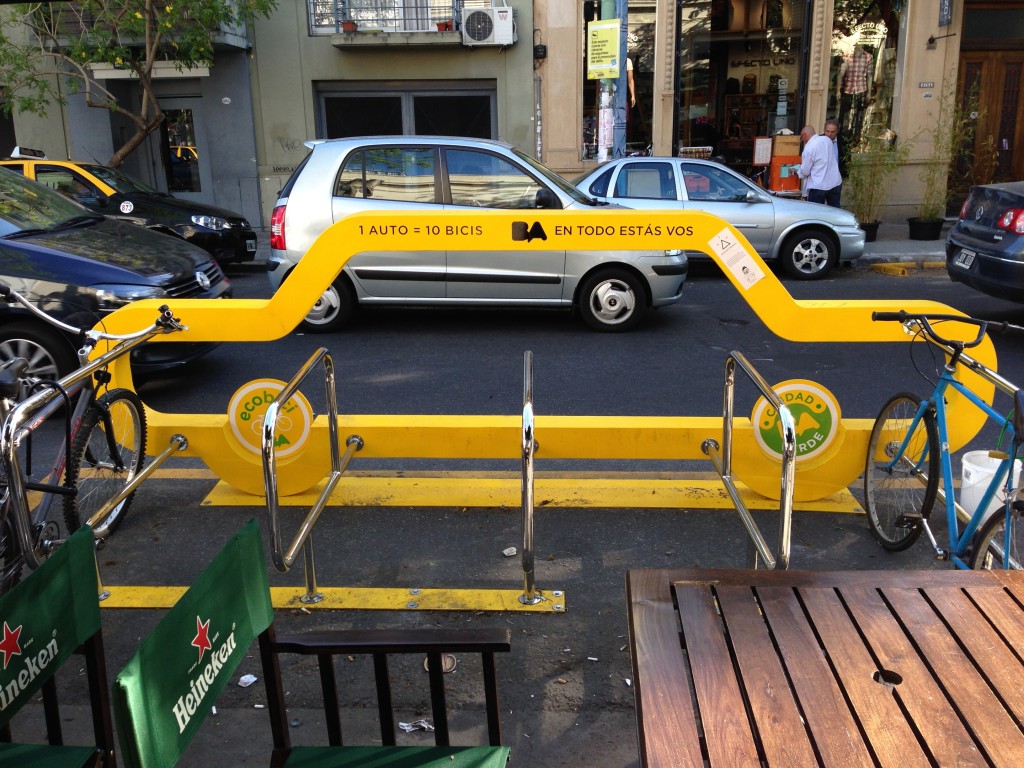
On-Street Bike Parking in Buenos Aires. Photo by the author.
I spotted this cool on-street bike rack in the trendy Palermo neighborhood of Buenos Aires. It says “One car = ten bikes”. It’s a very cool, visual way of providing bicycle parking in a neighborhood with narrow sidewalks and heavy pedestrian activity that also educates the driving public on the efficiency of travel by bicycle and the need for on-street bike infrastructure.
Metro’s planners recognize that bike parking is a really efficient use of space and a cost-effective way for us to provide alternatives for how our riders get to our stations. Read more about Metro’s bike parking efforts on PlanItMetro.
Editor’s note: we have been made aware that this bike rack design is very similar to or perhaps based on a bike rack design by a company called Cyclehoop. Congrats to Cyclehoop for such an innovative and educational design.
Metro is considering a small fare increase and no changes to the fare structure for the FY15 Budget.
Every autumn, Metro staff begins the process of developing the budget for the next fiscal year, which starts on July 1 of the following calendar year. Every other year, per Metro Board resolution, the budget proposal can contain a fare increase intended to match the fares to the changes in the consumer price index (CPI).
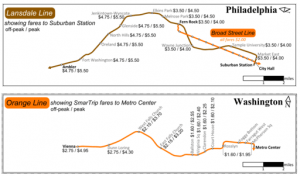
Comparison of SEPTA heavy rail and commuter rail fares and distances to Metrorail’s Orange Line, credit Matt Johnson via Greater Greater Washington. Click image for original context.
More than three years ago, Metro developed a new ridership and revenue model that allowed us to better evaluate the ridership and revenue impacts of potential changes to our fare structure. Staff used this model to evaluate concepts that could be incorporated into the FY13 budget to increase the alignment between fares and our fare policy principles.
At that time, Metro got a lot of input from the Greater Greater Washington community, as they discussed many aspects of Metro fares as compared to other system fare structures, including:
Read more…
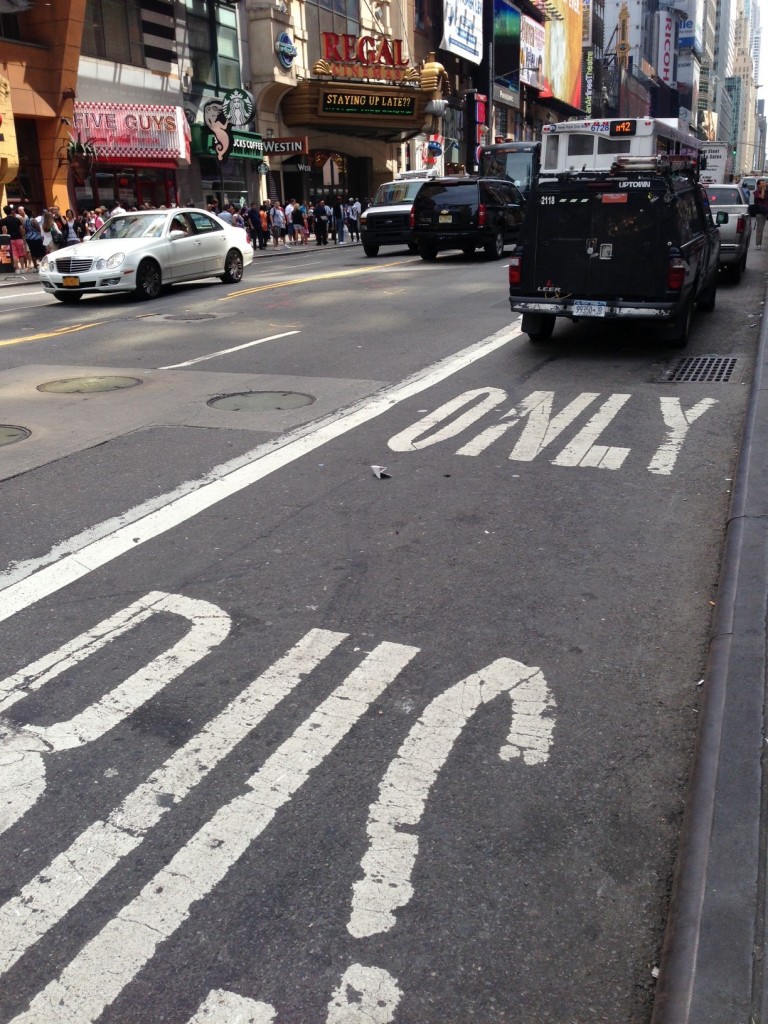
Photo of New York City bus lane violation.
This picture of a bus lane in New York City shows how easily bus priority treatments can be violated without enforcement mechanisms in place. Traffic control officers, bus-mounted cameras or self-enforcing contra-flow lanes can help ensure that street space dedicated to buses is available for them to use. Bus priority is a hot topic here at PlanItMetro.
Metrorail’s distance-based fare structure is the most equitable.
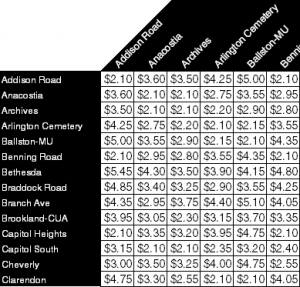
Excerpt of Metrorail distance-based fare table.
Metrorail is one of only three heavy rail systems in the United States with distance-based fares. (BART and PATCO are the other two.) And to the best of my knowledge, it’s the only one with peak and off-peak fares. With 86 stations (soon to be 91) and two fare time-periods (it used to be three), the average rider has a large number of possible fare combinations.
The benefits of Metrorail’s existing fare structure are many-fold, but chief among them are equity, efficiency, and economics.
The fare structure is fair. Distance-based and time-of-day fares allow transit riders to pay fares in proportion to the level of service they’re using. Peak period riders pay more and have more frequent service. Short distance travel is less expensive than long-distance. With flat fares, those who take short trips subsidize those who take longer trips, and people who ride during times of reduced service subsidize those who ride during the peaks when trains are most frequent. With zone-based fares, customers taking short trips that cross a zone boundary pay a larger fare than other customers taking longer trips entirely within a zone boundary.
The fare structure is equitable. A switch from distance-based to flat-fare that was revenue neutral (not losing money) would raise a Title VI equity concern. Planning staff have done a preliminary analysis, and such a switch would have a disproportionate burden on low-income riders. A switch to flat fares that was not revenue neutral would result in higher subsidies from Metro’s funding partners
The fare structure promotes economic efficiency. People use resources more efficiently if they’re priced to reflect the value of the resource. Economists love variably priced roads like the Intercounty Connector (MD-200) and the I-495 Express Lanes, as the per-mile prices are set to keep traffic flowing. The same concept applies to Metrorail’s distance-based and peak/off-peak fares. Read more…
The Silver Line will relieve traffic congestion on the Dulles Toll Road and I-66 when it opens in 2014.
This post is a continuation of our series that answers questions about the new Silver Line.
It’s no secret that the Washington region has some of the worst traffic in the country. Listeners to “drive time” radio are bombarded with rapid-fire traffic reports noting congestion on major regional highways, often caused by “nothing but volume”. This expression means there is no traffic accident, weather incident or excessive sunshine slowing cars down. Instead, too many cars are trying to squeeze into too few lanes at critical interchanges, resulting in traffic queues that can extend for miles and miles.
Not surprisingly, the highways along the Silver Line corridor are some of the region’s most congested. The merging of I-66 and the Dulles Toll Road was ranked fourth worst congested location (PDF) in the MWCOG Spring 2011 Traffic Survey. The survey showed the toll road has three major congestion spots in the AM Peak: the toll plaza, the interchange with the Capital Beltway and the merger with I-66. In all three cases, the recurring congestion was caused by vehicles weaving and merging.
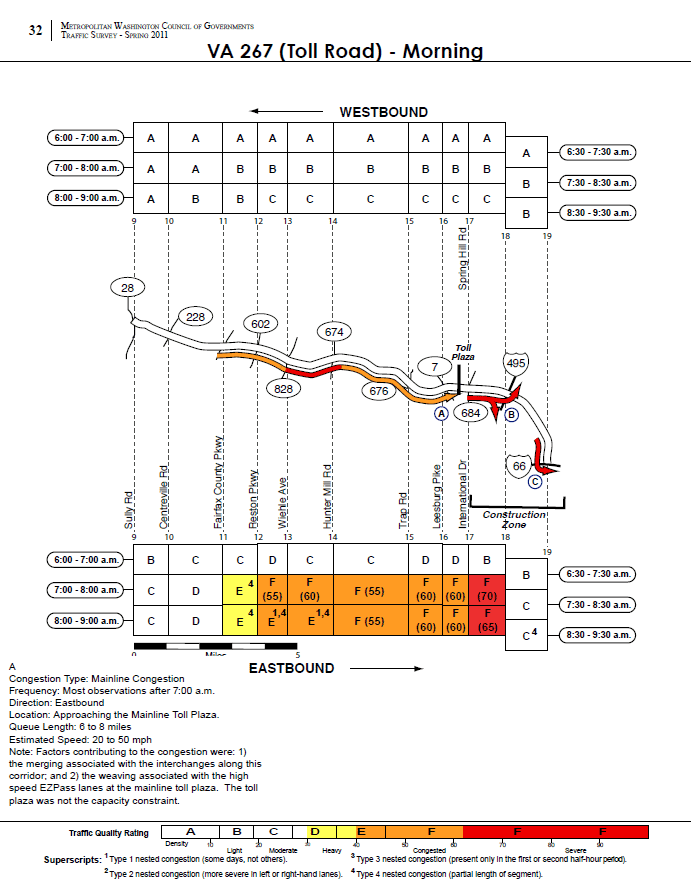
Surveyed morning traffic conditions on the Dulles Toll Road, from the MWCOG 2011 Traffic Survey. Image links to PDF report.
According to the MWCOG report, the speed in the traffic queue is between 20 and 50 MPH. This would result in between 2 and 12 minutes of delay per vehicle joining the back of the queue heading to the toll plaza. Assuming a duration of 2 hours for the queue, average vehicle occupancy of 1.1 and 1,900 vehicles per lane per mile, this results in between 560 and 3,300 person-hours of delay per day, up to 840,000 person hours per year. Read more…
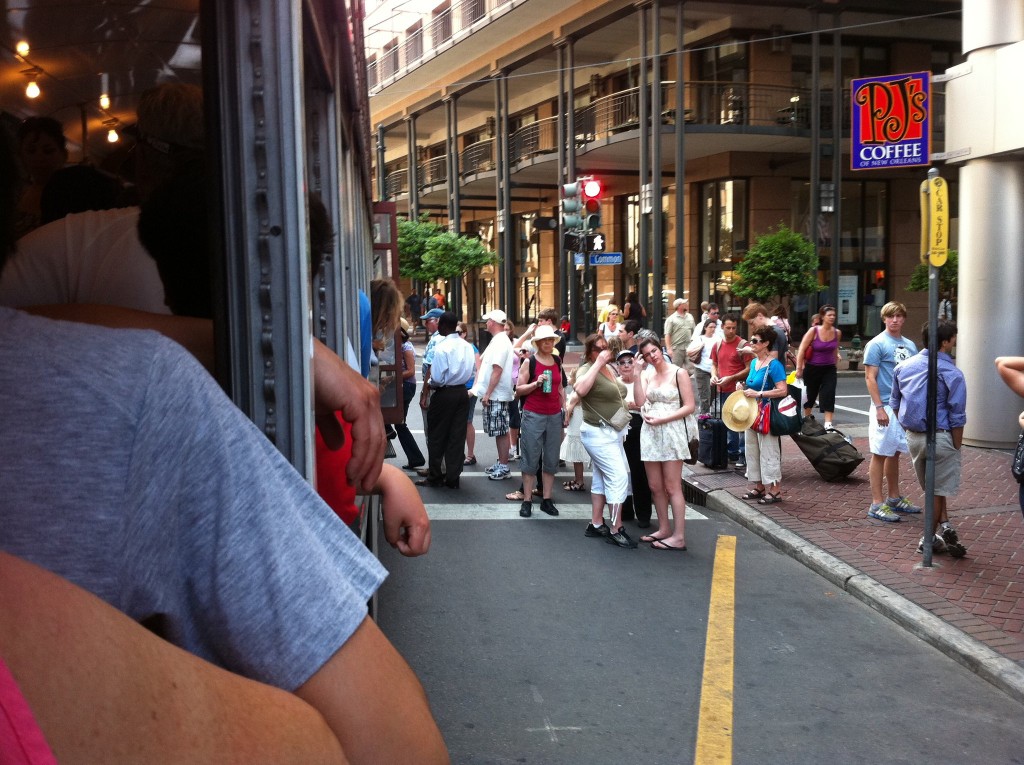
A crowd of tourists wait to board the St. Charles Streetcar.
A few years ago I visited New Orleans and took the St. Charles Streetcar from downtown to the terminus by Jefferson Ave. The stop where my friends and I boarded had a ticket vending machine, which we used. The stop pictured, however, did not. I shared this picture with friends, entitled “Twenty-Plus Reasons For Off-Board Fare Payment.”
Metro is currently investigating options for off-board SmarTrip loading.
Metro seeks to reduce delays to Metrobus caused by on-board SmarTrip card loading by installing off-board SmarTrip® Recharge Stations at key locations across the region.
Metro has been quite successful at increasing the use of SmarTrip® card usage on both bus and rail. As noted in a previous post, many initiatives — including surcharges for paying cash — have been successful at raising the the SmarTrip® use rate to about 90% on both Metrorail and Metrobus. As many readers have noted, many Metrobus customers load small amounts of cash — enough for one or two trips — onto their SmarTrip card in order to avoid the surcharge. This on-board load transaction can take between five and 30 seconds and, on average, one out of every 14 trips on Metrobus involves a small value load. On some routes it’s as frequent as one out of every seven. This behavior results in longer dwell times, slower rides, and less efficient operations of Metrobus.
One possible solution is to increase the opportunities for loading value onto SmarTrip cards before the customer boards. While SmarTrip cards can be reloaded online, at Metrorail stations and at a variety of retail outlets around the region, the frequency of on-board loading indicates the need for additional, convenient opportunities to add value to SmarTrip cards.
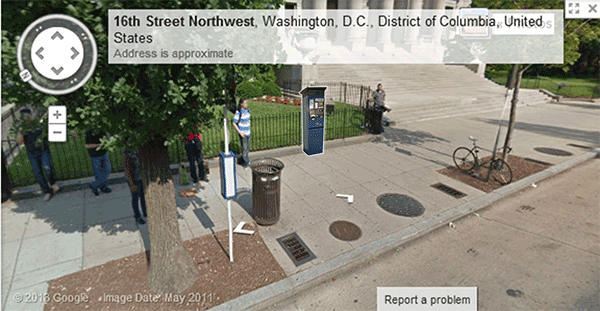
Example of potential SmarTrip Reload Station size and location. Image updates every 5 seconds. Click image for larger version.
Metro is seeking to meet this need by developing and deploying SmarTrip Recharge Stations (SRS) at selected bus stops around the region. In addition to facilitating the loading of fares and passes to SmarTrip cards and working with Metro’s current back-end systems, the requirements for these recharging stations include: Read more…
A new dedicated busway along “the widest street in the world” has reduced friction between buses and cars, but created some new friction between preservationists and government officials in Buenos Aires.
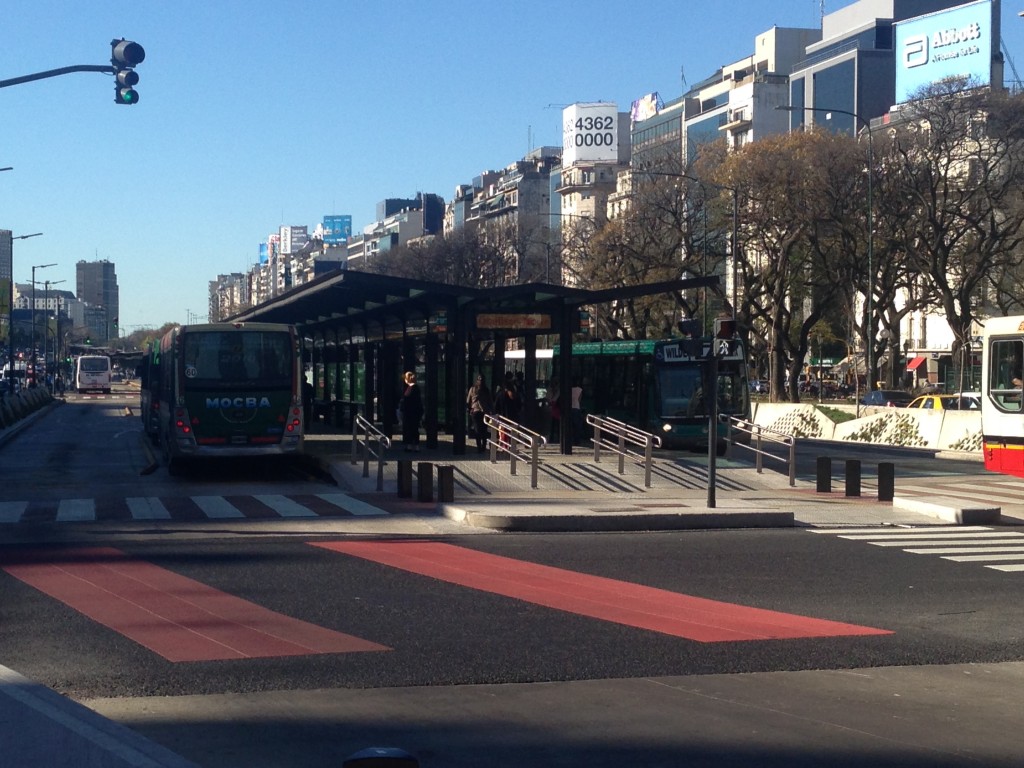
Median contraflow busway along Av 9 de Julio.
I just returned from my honeymoon in Buenos Aires. One of the first things I noticed while exploring the downtown “micro center” was a four-lane contraflow busway along Av 9 de Julio, often referred to as the widest street in the world.
Av 9 de Julio is literally a block wide — check out this jaw-dropping photo — with 7 traffic lanes in each direction in the main roadway and an additional 2 lanes of access road, also in each direction. Up until recently, buses traveled in the access lanes, conflicting with cars and pedestrians. A new four-lane busway facility was recently constructed along the center of this massive avenue. The facility is well lit, attractive and fast: the bus travel time down the three-kilometer roadway is expected to drop from 60 minutes to 20. Read more…
Metro requests feedback on draft Greenhouse Gas (GHG) calculator.
As part of the 40 Days of Momentum, a recent blog post the importance of Metro to the region, including greenhouse gas (GHGs) emissions reductions. Now it is your turn to look up your share of those GHG reductions.
Please try out our draft Greenhouse Gas Calculator, which asks for a starting and ending address, and then routes your trip via automobile and transit and displays the route and GHG emissions differences.* We are soft-launching this tool to crowd-source the quality assurance process and assess its usefulness.
Launch the GHG Emissions Savings Calculator!
What other features would you like to see? Did the tool accurately portray your travel choices? What is the difference in GHGs between driving and transit for your most frequent trip?
* Note on GHG calculations: the tool uses the Google Directions API to route your trip using both automobile and transit. The Google Directions API response includes each step of the journey, including mode and distance. We apply standard rates of GHG emissions per mile to the different modes used. As an added bonus, if your transit trip includes walking, we toss in an estimate of the calories you burned too!
The stations on the new Silver Line are two minutes apart in the Tysons area, and the Tysons-area stations are eight minutes away from both East Falls Church and Wiehle-Reston East.
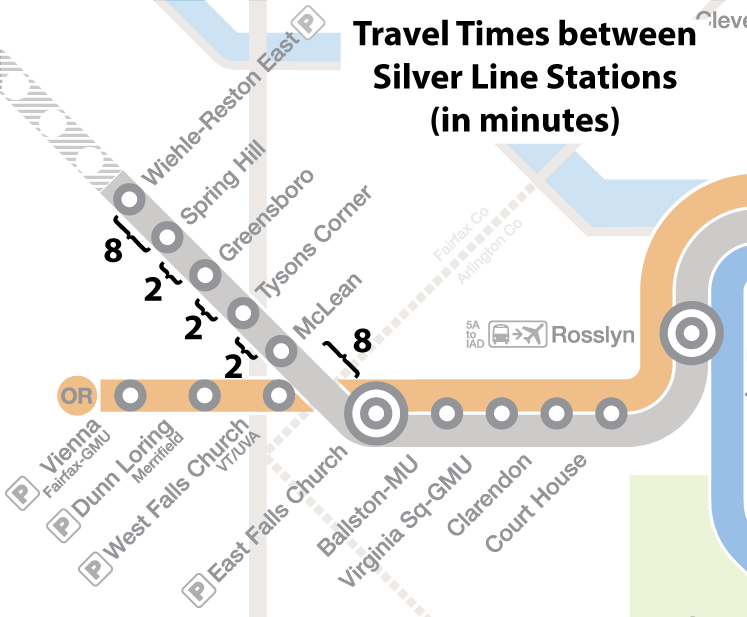
Draft travel times for the new Silver Line stations.
Earlier this year we published a series of posts about the region’s newest rail line, the Silver Line, due to begin service in early 2014. Those posts included answering the questions, “Where will it go?“, “What will happen to rail schedules?“, and “What will happen to bus schedules?“.
Now it’s time to talk about preliminary travel times between Silver Line stations. The map above illustrates the estimated travel times between the five new stations. These times are preliminary and may be refined after operational testing has been completed.
Below is a widget that can be used to look up the travel times between any two stations, including the five new Silver Line stations.*
Read more…











Recent Comments